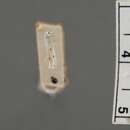Comprehensive Description
provided by Memoirs of the American Entomological Society
Elachista symmorpha new species (Figs. 60, 60a.)
Head white, palpi white, the third segment very slender and acute. Thorax and fore wings white ; a very faint ocherous tinge along costa and in the apical third of the wing; in this costal area and in the apical half of the wing there are scattered minutely brown-tipped scales. In the fold at two-thirds its length, dark brown scales form an irregular spot; at the end of the cell a larger elongate oval dark brown spot ; on the dorsal margin obliquely basad of the discal spot, an irregular group of dark brown sca'es ; scales at the apex of the wing broadly dark brown-tipped, forming a more or less irrorated dark patch ; scattered dark scales along termen ; the brown tips of the elongate scales at apex and along termen form a distinct dark line in the cilia. Hind wings and cilia pale straw-colored. Legs white, fore pair dark fuscous inwardly; tarsi except tips inwardly fuscous. Abdomen pale ocherous, shaded with fuscous.
Alar expanse: 12 to 13 mm.
Male genitalia (figs. 60, 60a): uncus lobes very small; costal margin of harpe nearly straight ; sacculus processes very stout, setose, not exceeding the anellus lobes; posterior margin of each anellus lobe strongly sinuate and produced at each side into an elongate posterior lobe, setose from apex to the lateral angle ; vinculum not produced ; aedeagus produced into a blind sac at base; cornuti consisting of an elongate sclerotized base bearing several small teeth and culminating in a larger conical tooth, and a group of numerous minute triangular spines near apex.
Type. — S, Monache Meadows, Tulare County, California, 8000 feet, July 1-7, [No. 34826, U. S. N. M.].
Paratypes. — i 6 , same data as the type, [U. S. N. M.] ; i 6 , without abdomen, same locality, July n, 191 7, [A. F. B. Coll. |.
Food plant and early stages unknown.
In wing markings this species comes nearest to the eastern orestella Busck, agreeing with it in the presence of the cluster of dark scales on dorsum near the end of the fold ; it is, however, somewhat larger and of different aspect. Differences in the male genitalia, especially in the shape of the anellus lobes, in aedeagus and cornuti separate the two species.
- bibliographic citation
- Braun, A.F. 1948. Elachistidae of North America (Microlepidoptera). Memoirs of the American Entomological Society vol. 13. Philadelphia, USA
Elachista symmorpha: Brief Summary
provided by wikipedia EN
Elachista symmorpha is a moth of the family Elachistidae. It is found in California and Oregon in the United States.
The length of the forewings is 5.5 mm. The costa in the basal fifth of the forewing is gray. The ground color is white, irregularly dusted with dark brown tips of scales, forming an elongate spot in the middle of the wing at the fold. The hindwings are light gray and the underside of the wings is brownish gray.
- license
- cc-by-sa-3.0
- copyright
- Wikipedia authors and editors

